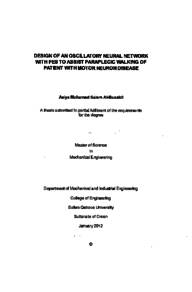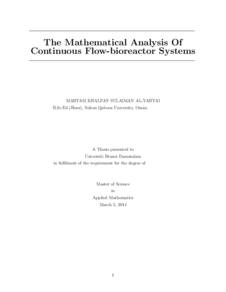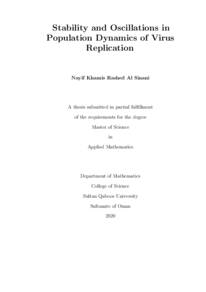وثيقة
Design of an oscillatory neural network with FES to assist paraplegic walking of patient with motor neuron disease
الناشر
Sultan Qaboos University
ميلادي
2012
اللغة
الأنجليزية
الموضوع
الملخص الإنجليزي
Abstract There are many diseases that affect the motor neurons of the human's nervous system. One of these diseases is the weakness and inability to control the leg muscles such as the case with foot drop condition. Foot drop usually results from an injury at the peroneal nerve which is responsible to control the lifting muscle of the leg, and as a result the foot and toes drop downward while lifting the leg causing unstable walking gait. To overcome this problem, many devices were developed to solve the foot drop condition taking in mind the fact that the muscle electrical conductivity is still intact although the nerves are disconnected from the brain. Thus, muscles can be stimulated by external electrical supply. For example, Functional Electrical Stimulation (FES) method replaces the function that has been lost by substituting the brain connection to the muscles. Drop-Foot Stimulator (DFS) is a special portable device designed to stimulate the peroneal nerve using surface electrodes to get rid of the foot drop and improves the walking movement. There are few commercialized devices such as WalkAide and NESS L300. However, these devices are very expensive to afford to Omani patients. In addition, they depend on a threshold value that needs to be tuned for individual condition after period of times to adjust his/her improved muscle condition. Modifying and tuning the device performance requires clinicians' supervision in hospitals. This study addresses the control of FES generation in the DFS devices using Neural Oscillators networks which is called Central Pattern Generators (CPG). A CPG network produces a stable cyclic rhythm which can be synchronized with the human walking motion if used with the aid of sensory feedback. The proposed CPG is based on a well known neural oscillator called Matsuoka since it has robust stable output and can be synchronized with the system's dynamics to produce more natural motions. A proposed CPG controller was tested on a simulation model of a biped robot with foot drop condition to mimic the human motion, since experimenting the FES directly on a real human might be harmful. The simulation results showed that the proposed CPG controller did control the foot drop by synchronizing with the robot walking gait using ZMP as sensory inputs. Finally, a modified Matsuoka oscillator was proposed to be used for the real FES by linking the oscillator parameters to FES properties.
المجموعة
URL المصدر
الملخص العربي
الخلاصة
يتميز الإنسان عن باقي المخلوقات بقدرته على التفكير والمشي على قدمين لأداء مهامه اليومية على نحو سلس. ففقد ان هذه الحركة تمنع الإنسان من القيام بمهامه العادية بسهولة. الشلل أو المشي المشلول هي حالة واحدة من هذه المشاكل التي تنتج عن طريق إصابات الدماغ أو النخاع الشوكي أو الأمراض التي تصيب الخلايا العصبية الحركية التي تؤثر على وظيفة هذه الخلايا. حيث انه في هذه الحالة، يفقد الشخص قدرته على السيطرة على العضلات. وتنتج المشية الغير مستقرة بسبب المشي المشلول وتصاحبها الصعوبات في تحقيق التوازن الذاتي. ويشار إلى عدم القدرة على رفع القدم وأصابع القدم أثناء المشي بحالة هبوط القدم أو كما يتعارف عليها بالانجليزية ب (Foot Drop). والمصاب بحالة هبوط القدم يحصل على العلاج الطبيعي لتحسين أداء مشيته. ومع ذلك، فإن العلاج الطبيعي لا يكفي التحريك الذاتي بسبب علم عمل الخلايا العصبية التي تسيطر على حركة العضلات. في بداية الستينات اقترح ليبرمون استخدام النبضات الكهربائية لتحفيز العضلات لتحل محل وظيفة الدماغ التحفيزية للخلايا العصبية الحركية، مع الأخذ في الاعتبار أن الموصلية الكهربائية في العضلات لا تزال على حالها على الرغم من قطع الأعصاب عن الدماغ. ويسمى هذا النوع من التحفيز الكهربائي "بالوظيفي" (FES)؛ لأنه يحفز على ترميم وظيفة العضلات الحركية. وقد تم تطوير العديد من الأجهزة التي تساهم على علاج حالة هبوط القدم والتي تسمى (Drop Foot Stimulators) أو (DFS) التي تقوم بتحفيز عضلة القدم عند المشي. ومع ذلك ، فإن عيوب تلك الأجهزة مثل WalkAide و NESS L300 هي أن كلفة توفيرها للمريض العماني مرتفعة للغاية، و بالإضافة إلى ذلك ، هذه الأجهزة تعتمد على قيمة العتبة التي لا بد من ضبطها كل مرة يدويا للمريض بعد فترة من العلاج لضبط أدائه مع مقدار تحسن العضلات. هذه العملية تتطلب إشراف الأطباء في المستشفيات، وبالتالي مراجعة المستشفى دائما مما قد يزعج المريض في بعض الأحيان. هذه الدراسة تقترح وسيلة جديدة يقوم من خلاها الجهاز بإنتاج النبضات الكهربائية على أساس شبكة صناعية تقوم بمحاكاة الخلايا العصبية المتذبذبة والمسمى ب(CPG). تنتج هذه الشبكة العصبية إيقاع متواتر و مستقر والتي يمكن الاستفادة منها في مزامنة عمل الجهاز مع حركة مشية الإنسان. و في هذه الدراسة تم او اقتراح شبكة عصبية تعتمد على نموذج ماتسوكا (Matsuoka) الذي يتميز باستقرار وقوة الإشارات المتدفقة منه وبالتي يمكن مزامنتها مع الأنظمة الميكانيكية لإنتاج حركة طبيعية أكثر. الشبكة العصبية المقترحة تم اختبارها على نموذج رجل آلي ذو قدمين ليحاكي حركة الإنسان، لأن تجريب النبضات الكهربائية مباشرة على الإنسان قد تكون خطيرة وضارة. كما أظهرت نتائج المحاكاة نجاح عملية التحكم بقدم الرجل الآلي بأستخدام الشبكة العصبية المقترحة، من خلال مزامنة عملها مع مشيته ومع الاستعانة ببعض المدخلات الحسية وأخيرا تم اقتراح تعديلات على شبكة ماتسوكا العصبية لاستخدمها مع النبضات الكهربائية عن طريق ربط خصائصها مع خصائص النبضات الكهربائية.
يتميز الإنسان عن باقي المخلوقات بقدرته على التفكير والمشي على قدمين لأداء مهامه اليومية على نحو سلس. ففقد ان هذه الحركة تمنع الإنسان من القيام بمهامه العادية بسهولة. الشلل أو المشي المشلول هي حالة واحدة من هذه المشاكل التي تنتج عن طريق إصابات الدماغ أو النخاع الشوكي أو الأمراض التي تصيب الخلايا العصبية الحركية التي تؤثر على وظيفة هذه الخلايا. حيث انه في هذه الحالة، يفقد الشخص قدرته على السيطرة على العضلات. وتنتج المشية الغير مستقرة بسبب المشي المشلول وتصاحبها الصعوبات في تحقيق التوازن الذاتي. ويشار إلى عدم القدرة على رفع القدم وأصابع القدم أثناء المشي بحالة هبوط القدم أو كما يتعارف عليها بالانجليزية ب (Foot Drop). والمصاب بحالة هبوط القدم يحصل على العلاج الطبيعي لتحسين أداء مشيته. ومع ذلك، فإن العلاج الطبيعي لا يكفي التحريك الذاتي بسبب علم عمل الخلايا العصبية التي تسيطر على حركة العضلات. في بداية الستينات اقترح ليبرمون استخدام النبضات الكهربائية لتحفيز العضلات لتحل محل وظيفة الدماغ التحفيزية للخلايا العصبية الحركية، مع الأخذ في الاعتبار أن الموصلية الكهربائية في العضلات لا تزال على حالها على الرغم من قطع الأعصاب عن الدماغ. ويسمى هذا النوع من التحفيز الكهربائي "بالوظيفي" (FES)؛ لأنه يحفز على ترميم وظيفة العضلات الحركية. وقد تم تطوير العديد من الأجهزة التي تساهم على علاج حالة هبوط القدم والتي تسمى (Drop Foot Stimulators) أو (DFS) التي تقوم بتحفيز عضلة القدم عند المشي. ومع ذلك ، فإن عيوب تلك الأجهزة مثل WalkAide و NESS L300 هي أن كلفة توفيرها للمريض العماني مرتفعة للغاية، و بالإضافة إلى ذلك ، هذه الأجهزة تعتمد على قيمة العتبة التي لا بد من ضبطها كل مرة يدويا للمريض بعد فترة من العلاج لضبط أدائه مع مقدار تحسن العضلات. هذه العملية تتطلب إشراف الأطباء في المستشفيات، وبالتالي مراجعة المستشفى دائما مما قد يزعج المريض في بعض الأحيان. هذه الدراسة تقترح وسيلة جديدة يقوم من خلاها الجهاز بإنتاج النبضات الكهربائية على أساس شبكة صناعية تقوم بمحاكاة الخلايا العصبية المتذبذبة والمسمى ب(CPG). تنتج هذه الشبكة العصبية إيقاع متواتر و مستقر والتي يمكن الاستفادة منها في مزامنة عمل الجهاز مع حركة مشية الإنسان. و في هذه الدراسة تم او اقتراح شبكة عصبية تعتمد على نموذج ماتسوكا (Matsuoka) الذي يتميز باستقرار وقوة الإشارات المتدفقة منه وبالتي يمكن مزامنتها مع الأنظمة الميكانيكية لإنتاج حركة طبيعية أكثر. الشبكة العصبية المقترحة تم اختبارها على نموذج رجل آلي ذو قدمين ليحاكي حركة الإنسان، لأن تجريب النبضات الكهربائية مباشرة على الإنسان قد تكون خطيرة وضارة. كما أظهرت نتائج المحاكاة نجاح عملية التحكم بقدم الرجل الآلي بأستخدام الشبكة العصبية المقترحة، من خلال مزامنة عملها مع مشيته ومع الاستعانة ببعض المدخلات الحسية وأخيرا تم اقتراح تعديلات على شبكة ماتسوكا العصبية لاستخدمها مع النبضات الكهربائية عن طريق ربط خصائصها مع خصائص النبضات الكهربائية.
قالب العنصر
الرسائل والأطروحات الجامعية



